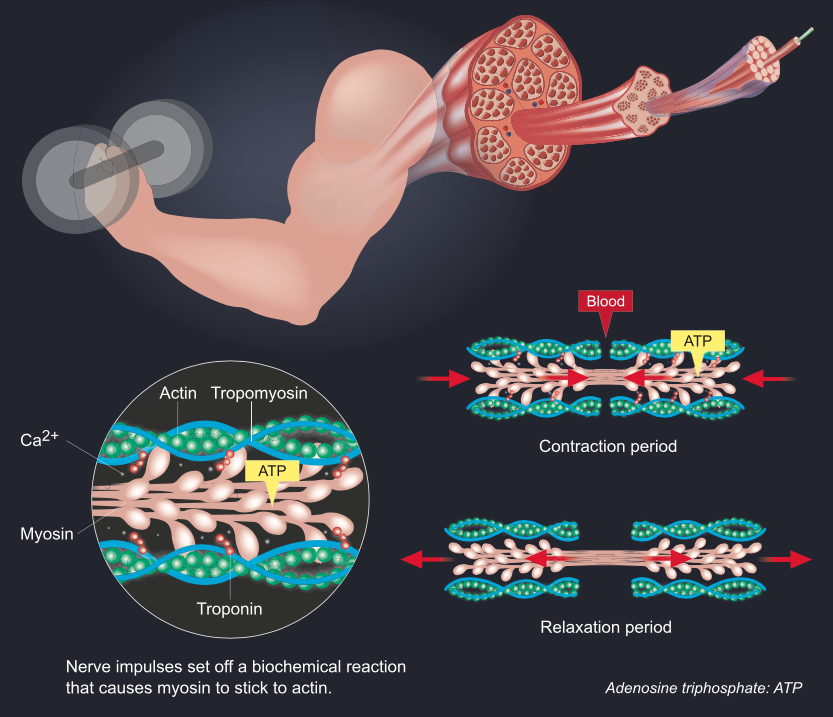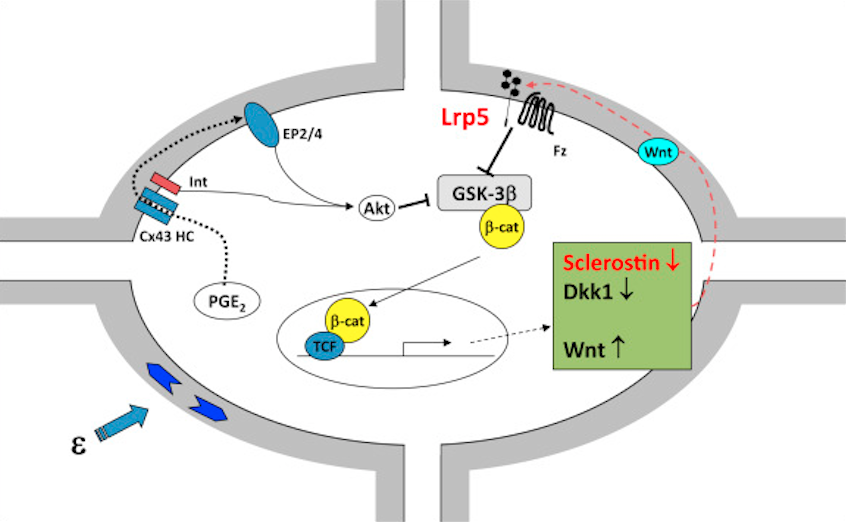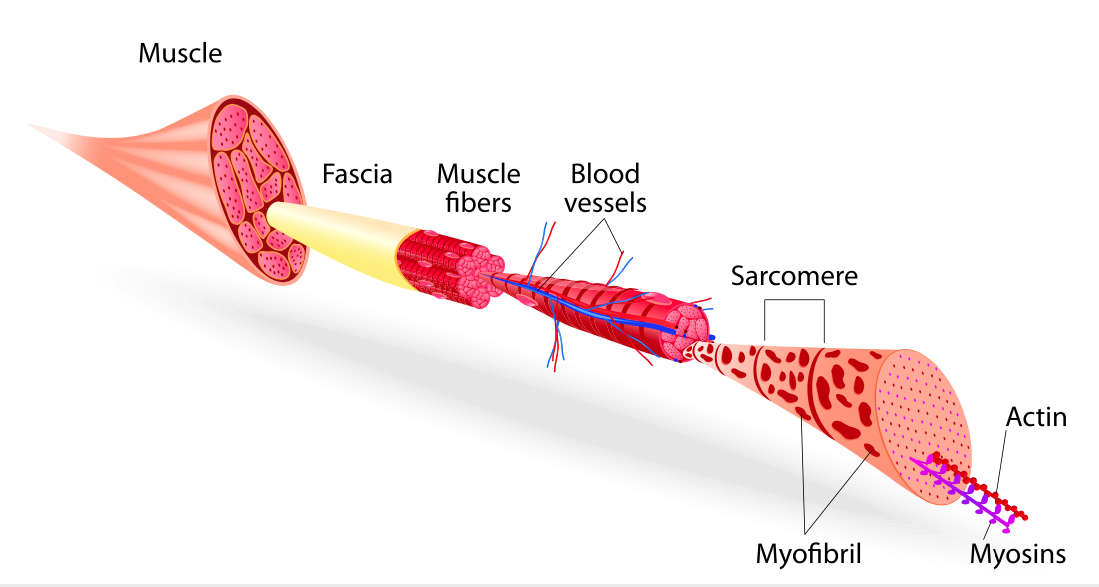[FONT="]How Muscles Grow
Muscles are composed of bundles of muscle cells, which are referred to as muscle fibres. Each contains many myofibrils, which are made up of actin and myosin filaments. When performing high-intensity exercise, such as my HIT3 program, they interact more and more until all the actin and myosin are working in synchrony to hold the muscle cell at a particular length (resisting the load) and then shortening the muscle, implying a concentric contraction (pushing the weight/load back up). The stimulus for growth comes from three main conditions: muscle damage, mechanosensation and metabolic fatigue.[/FONT]
[FONT="]Growth Stimulus #1: Muscle Damage[/FONT]
[FONT="]

Muscle growth occurs when the muscle cell is being confronted with a weight or level of resistance that it has never encountered before. During the performance of the exercise movement, the locking of the myosin to actin can lead to the breaking apart of these tiny tissues because they simply haven’t developed enough to withstand the load and intensity placed on them. This damage inside the muscle cell, as well as the stretch of the eccentric (stretching part of the lifting movement), leads to disturbances in the muscle cell membrane. This is what scientists consider to be muscle damage. This needs to be repaired before the next time you train. This is where most people go wrong with their training: by not giving their body enough rest time between workouts to fully recuperate, to allow for muscle cell repair and growth.[/FONT]
[FONT="]Growth Stimulus #2: Mechanosensation[/FONT]
[FONT="]

The next growth stimulus is mechanosensation, which may be the most important driver of muscle growth. When the muscle contracts, the muscle cell has enzymes, proteins and molecules that sense this change in behaviour and induce a signal. The mechanisms are still being figured out, but one of them is phospholipase D (PLD). When the cell membrane stretches and contracts, the PLD protein interacts with a molecule on the cell surface and chemically changes the molecule, and this chemical change leads to downstream signals that induce muscle cell growth. The changes in the cellmembrane (from stretching and contracting together by vigorous, high-intensity exercise such as my HIT3 method) lead to the generation of cell-signaling molecules, which force the cell to make more proteins, leading to muscle growth.[/FONT]
[FONT="]Growth Stimulus #3: Metabolic Fatigue[/FONT]
[FONT="]

Metabolic fatigue can also induce signaling for the muscle cell to grow, although the exact mechanisms aren’t altogether clear. What we do know is that when actin and myosin interact, they use energy, which creates a by-product known as a proton. The accumulation of protons increases the acidity in the muscle and leads to the burning sensation we’ve all feltwhen training with high intensity, especially during the last excruciating reps of an all-out set. This increased acidity signals to the muscle cells to grow. It’s for this reason that pushing past the burn and going past failure is the key to gaining muscle as quickly as possible. The set starts when the reps start getting hard.[/FONT]
[FONT="]All three growth stimuli create situations where a muscle’s proteins sense these changes (contractions) at the cellular level, or sense damage to the proteins in the muscle. It’s for this reason that a well-thought-out training system needs to maximize all three pathways in order to make the best gains possible.[/FONT]
[FONT="]Muscles are composed of bundles of muscle cells, which are referred to as muscle fibres. Each contains many myofibrils, which are made up of actin and myosin filaments. When performing high-intensity exercise, such as my HIT3 program, they interact more and more until all the actin and myosin are working in synchrony to hold the muscle cell at a particular length (resisting the load) and then shortening the muscle, implying a concentric contraction (pushing the weight/load back up). The stimulus for growth comes from three main conditions: muscle damage, mechanosensation and metabolic fatigue.[/FONT]
[FONT="]Growth Stimulus #1: Muscle Damage[/FONT]
[FONT="]

Muscle growth occurs when the muscle cell is being confronted with a weight or level of resistance that it has never encountered before. During the performance of the exercise movement, the locking of the myosin to actin can lead to the breaking apart of these tiny tissues because they simply haven’t developed enough to withstand the load and intensity placed on them. This damage inside the muscle cell, as well as the stretch of the eccentric (stretching part of the lifting movement), leads to disturbances in the muscle cell membrane. This is what scientists consider to be muscle damage. This needs to be repaired before the next time you train. This is where most people go wrong with their training: by not giving their body enough rest time between workouts to fully recuperate, to allow for muscle cell repair and growth.[/FONT]
[FONT="]Growth Stimulus #2: Mechanosensation[/FONT]
[FONT="]

The next growth stimulus is mechanosensation, which may be the most important driver of muscle growth. When the muscle contracts, the muscle cell has enzymes, proteins and molecules that sense this change in behaviour and induce a signal. The mechanisms are still being figured out, but one of them is phospholipase D (PLD). When the cell membrane stretches and contracts, the PLD protein interacts with a molecule on the cell surface and chemically changes the molecule, and this chemical change leads to downstream signals that induce muscle cell growth. The changes in the cellmembrane (from stretching and contracting together by vigorous, high-intensity exercise such as my HIT3 method) lead to the generation of cell-signaling molecules, which force the cell to make more proteins, leading to muscle growth.[/FONT]
[FONT="]Growth Stimulus #3: Metabolic Fatigue[/FONT]
[FONT="]

Metabolic fatigue can also induce signaling for the muscle cell to grow, although the exact mechanisms aren’t altogether clear. What we do know is that when actin and myosin interact, they use energy, which creates a by-product known as a proton. The accumulation of protons increases the acidity in the muscle and leads to the burning sensation we’ve all feltwhen training with high intensity, especially during the last excruciating reps of an all-out set. This increased acidity signals to the muscle cells to grow. It’s for this reason that pushing past the burn and going past failure is the key to gaining muscle as quickly as possible. The set starts when the reps start getting hard.[/FONT]
[FONT="]All three growth stimuli create situations where a muscle’s proteins sense these changes (contractions) at the cellular level, or sense damage to the proteins in the muscle. It’s for this reason that a well-thought-out training system needs to maximize all three pathways in order to make the best gains possible.[/FONT]
Muscles are composed of bundles of muscle cells, which are referred to as muscle fibres. Each contains many myofibrils, which are made up of actin and myosin filaments. When performing high-intensity exercise, such as my HIT3 program, they interact more and more until all the actin and myosin are working in synchrony to hold the muscle cell at a particular length (resisting the load) and then shortening the muscle, implying a concentric contraction (pushing the weight/load back up). The stimulus for growth comes from three main conditions: muscle damage, mechanosensation and metabolic fatigue.[/FONT]
[FONT="]Growth Stimulus #1: Muscle Damage[/FONT]
[FONT="]

Muscle growth occurs when the muscle cell is being confronted with a weight or level of resistance that it has never encountered before. During the performance of the exercise movement, the locking of the myosin to actin can lead to the breaking apart of these tiny tissues because they simply haven’t developed enough to withstand the load and intensity placed on them. This damage inside the muscle cell, as well as the stretch of the eccentric (stretching part of the lifting movement), leads to disturbances in the muscle cell membrane. This is what scientists consider to be muscle damage. This needs to be repaired before the next time you train. This is where most people go wrong with their training: by not giving their body enough rest time between workouts to fully recuperate, to allow for muscle cell repair and growth.[/FONT]
[FONT="]Growth Stimulus #2: Mechanosensation[/FONT]
[FONT="]

The next growth stimulus is mechanosensation, which may be the most important driver of muscle growth. When the muscle contracts, the muscle cell has enzymes, proteins and molecules that sense this change in behaviour and induce a signal. The mechanisms are still being figured out, but one of them is phospholipase D (PLD). When the cell membrane stretches and contracts, the PLD protein interacts with a molecule on the cell surface and chemically changes the molecule, and this chemical change leads to downstream signals that induce muscle cell growth. The changes in the cellmembrane (from stretching and contracting together by vigorous, high-intensity exercise such as my HIT3 method) lead to the generation of cell-signaling molecules, which force the cell to make more proteins, leading to muscle growth.[/FONT]
[FONT="]Growth Stimulus #3: Metabolic Fatigue[/FONT]
[FONT="]

Metabolic fatigue can also induce signaling for the muscle cell to grow, although the exact mechanisms aren’t altogether clear. What we do know is that when actin and myosin interact, they use energy, which creates a by-product known as a proton. The accumulation of protons increases the acidity in the muscle and leads to the burning sensation we’ve all feltwhen training with high intensity, especially during the last excruciating reps of an all-out set. This increased acidity signals to the muscle cells to grow. It’s for this reason that pushing past the burn and going past failure is the key to gaining muscle as quickly as possible. The set starts when the reps start getting hard.[/FONT]
[FONT="]All three growth stimuli create situations where a muscle’s proteins sense these changes (contractions) at the cellular level, or sense damage to the proteins in the muscle. It’s for this reason that a well-thought-out training system needs to maximize all three pathways in order to make the best gains possible.[/FONT]
[FONT="]Muscles are composed of bundles of muscle cells, which are referred to as muscle fibres. Each contains many myofibrils, which are made up of actin and myosin filaments. When performing high-intensity exercise, such as my HIT3 program, they interact more and more until all the actin and myosin are working in synchrony to hold the muscle cell at a particular length (resisting the load) and then shortening the muscle, implying a concentric contraction (pushing the weight/load back up). The stimulus for growth comes from three main conditions: muscle damage, mechanosensation and metabolic fatigue.[/FONT]
[FONT="]Growth Stimulus #1: Muscle Damage[/FONT]
[FONT="]

Muscle growth occurs when the muscle cell is being confronted with a weight or level of resistance that it has never encountered before. During the performance of the exercise movement, the locking of the myosin to actin can lead to the breaking apart of these tiny tissues because they simply haven’t developed enough to withstand the load and intensity placed on them. This damage inside the muscle cell, as well as the stretch of the eccentric (stretching part of the lifting movement), leads to disturbances in the muscle cell membrane. This is what scientists consider to be muscle damage. This needs to be repaired before the next time you train. This is where most people go wrong with their training: by not giving their body enough rest time between workouts to fully recuperate, to allow for muscle cell repair and growth.[/FONT]
[FONT="]Growth Stimulus #2: Mechanosensation[/FONT]
[FONT="]

The next growth stimulus is mechanosensation, which may be the most important driver of muscle growth. When the muscle contracts, the muscle cell has enzymes, proteins and molecules that sense this change in behaviour and induce a signal. The mechanisms are still being figured out, but one of them is phospholipase D (PLD). When the cell membrane stretches and contracts, the PLD protein interacts with a molecule on the cell surface and chemically changes the molecule, and this chemical change leads to downstream signals that induce muscle cell growth. The changes in the cellmembrane (from stretching and contracting together by vigorous, high-intensity exercise such as my HIT3 method) lead to the generation of cell-signaling molecules, which force the cell to make more proteins, leading to muscle growth.[/FONT]
[FONT="]Growth Stimulus #3: Metabolic Fatigue[/FONT]
[FONT="]

Metabolic fatigue can also induce signaling for the muscle cell to grow, although the exact mechanisms aren’t altogether clear. What we do know is that when actin and myosin interact, they use energy, which creates a by-product known as a proton. The accumulation of protons increases the acidity in the muscle and leads to the burning sensation we’ve all feltwhen training with high intensity, especially during the last excruciating reps of an all-out set. This increased acidity signals to the muscle cells to grow. It’s for this reason that pushing past the burn and going past failure is the key to gaining muscle as quickly as possible. The set starts when the reps start getting hard.[/FONT]
[FONT="]All three growth stimuli create situations where a muscle’s proteins sense these changes (contractions) at the cellular level, or sense damage to the proteins in the muscle. It’s for this reason that a well-thought-out training system needs to maximize all three pathways in order to make the best gains possible.[/FONT]
